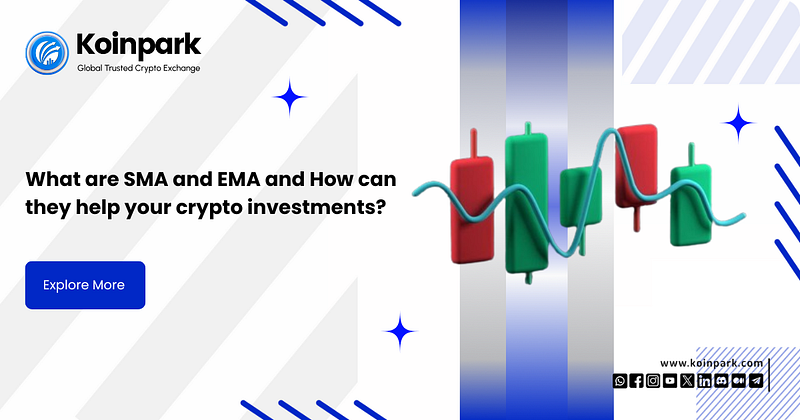Introduction:
There are many types of moving averages, but the most commonly used ones are the Simple Moving Average (SMA) and the Exponential Moving Average (EMA).
In tracking crypto prices, people often look at the average price over certain periods, like 50 days, 100 days, and 200 days. The 50-day and 200-day averages are the most popular.
Let’s explore the nuances of the Simple Moving Average (SMA) and the Exponential Moving Average (EMA) in more detail.
Simple Moving Average (SMA):
A simple moving average is found by adding up the closing prices of a cryptocurrency for the past 50 days and then dividing that total by 50. This gives you the average price over that time.
Navigate to the TradingView website, first click on “Indicators and Strategies.” Then search for “simple moving average” and select the options for 50, 100, and 200 days.
In 2015, there was a day when the 50-day moving average went above the 200-day moving average. From that day forward, the 50-day average stayed above the 200-day average without going below it again.
Example:
Calculating the SMA:
Scenario: Imagine you’re interested in the 20-day SMA for the price of Bitcoin (BTC). You have the daily closing prices of BTC for the past 20 days.
Steps:
Sum the closing prices: Add the closing prices of BTC for the last 20 days.
- Sum = Σ (BTC closing price on day i), where i goes from 1 to 20.
Divide the sum by the number of periods:
- SMA (20 days) = Sum / 20
Interpretation:
- The resulting value represents the average closing price of BTC over the past 20 days. This helps smooth out short-term price fluctuations and potentially reveal the underlying trend.
Golden Cross and Death Cross:
When the 50-day moving average crosses above the 200-day moving average, it’s called a “Golden Cross.” This signals a positive trend.
In 2018, there was a change when the 50-day moving average cut through the 200-day moving average and moved downwards, known as a “Death Cross,” indicating a negative trend.
Remember, you shouldn’t use it alone. It’s best to combine it with other tools like RSI or Stoch RSI to make your own decisions.
For long-term investors, the Simple Moving Average (SMA) is highly useful, particularly for those planning to hold their investments for durations such as 6 months or a year.
This strategy is valuable for anyone looking for the best exchange to buy Bitcoin in India, as it provides a solid foundation for making long-term investment decisions.
Sometimes the simple moving average (SMA) can give misleading signals. The simple moving average (SMA) is good for long-term investors. It’s helpful if you plan to buy and hold your investment for 6 months or a year.
Exponential Moving Average(EMA):
The 50-day Exponential Moving Average (EMA) focuses more on the last 10 days, which is ideal for short-term traders, like day traders, because it quickly adjusts to recent price movements.
Example :
Calculating the EMA:
The EMA is calculated using the following formula:
EMA (today) = (α * Price (today)) + ((1 — α) * EMA (yesterday))
where:
- α is the smoothing factor (between 0 and 1). A higher alpha value gives more weight to recent prices.
- Price (today) is the closing price today.
- EMA (yesterday) is the EMA value from yesterday.
Interpretation:
The EMA reflects the average price but with more significance given to the most recent price points. This can be helpful in identifying short-term trends and recent price movements quicker than the SMA.
Choose a smoothing factor (α): Let’s use α = 0.2 (a common choice for short-term EMA).
Calculate the EMA for each day:
- Day 1: EMA (1) = (0.2 * $20) + (1–0.2) * (unknown) = $20 (since EMA on day 0 is unknown, we assume the price on day 1)
- Day 2: EMA (2) = (0.2 * $22) + (1–0.2) * ($20) = $20.40
- Day 3: EMA (3) = (0.2 * $25) + (1–0.2) * ($20.40) = $21.32
… and so on
This quick adjustment feature is crucial for participants in a global cryptocurrency exchange, as it helps them make informed decisions based on the latest market trends.
To find the exponential moving average on TradingView, first, go to the Tradingview website, then look for “Indicators and Strategies” and search for “EMA.”
Conclusion:
I hope this blog has provided you with a foundational understanding of SMA and EMA. By applying these techniques to analyze the Bitcoin or other altcoin markets, especially now when Bitcoin’s price is high, you might consider it a good time to invest.
If you’re wondering how to buy Bitcoin in India or looking to convert Bitcoin to Indian rupees, these insights could be particularly valuable as you navigate your investment journey in the cryptocurrency space.




.png)

Comments